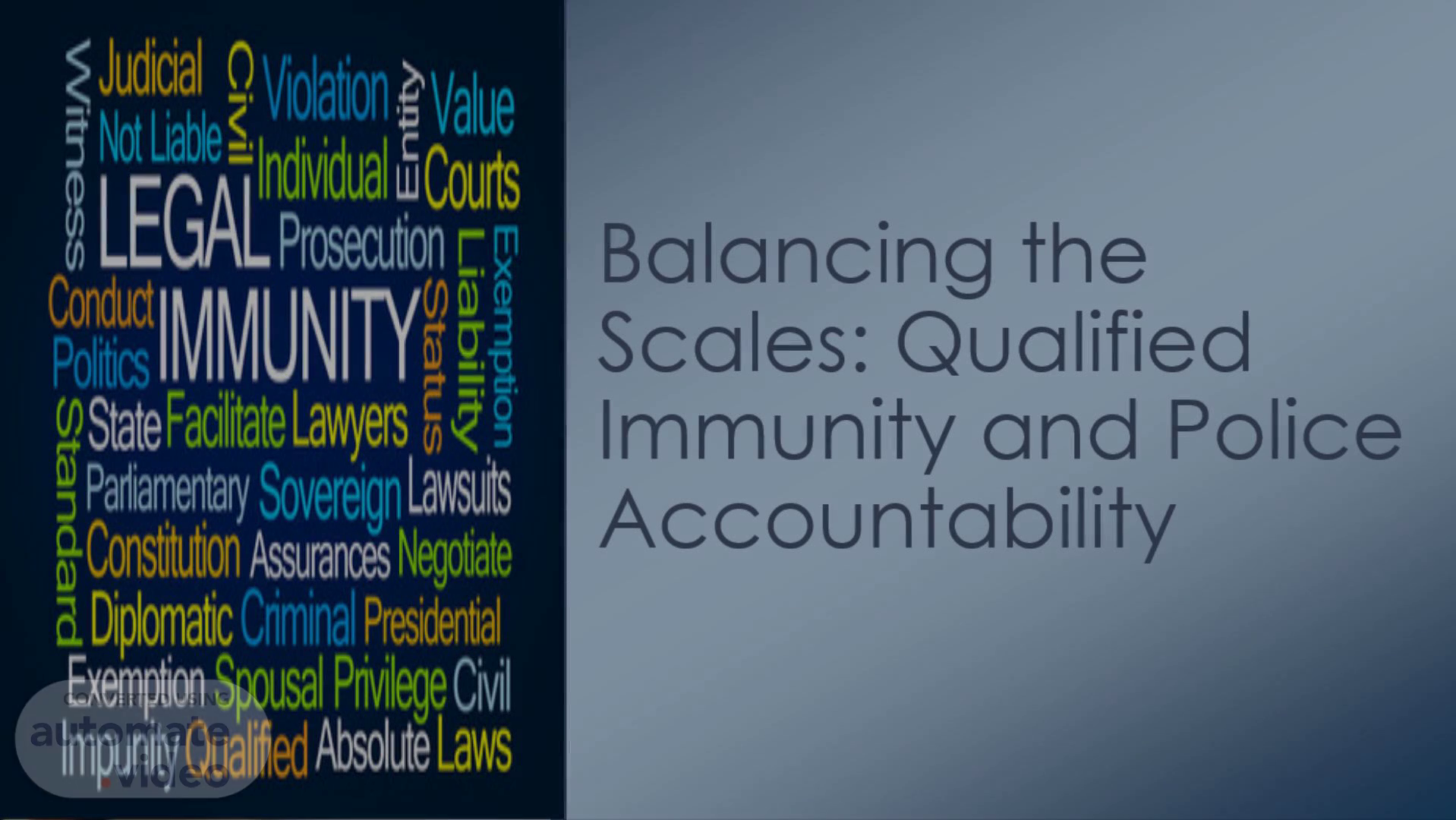
Page 1 (0s)
Balancing the Scales: Qualified Immunity and Police Accountability.
Page 2 (15s)
Qualified Immunity: A shield or a Loophole? What is qualified immunity and its purpose The rise of the police accountability movement. Real-world exampls through case studies. Whether these two concepts can coexist. Recommendations for moving forward. Challenges in applying qualified immunity..
Page 3 (31s)
Isometric arrested offender with policeman characters standing on Law book, scales of justice, gavel, handcuffs, flat vector illustration. Police officers arresting criminal, thief. Law and justice..
Page 4 (57s)
undefined. The Police Accountability Movement. This movement has gained significant momentum in recent years, calling for greater transparency and accountability in law enforcement. High-profile incidents of police brutality and racial profiling have fueled public outrage and demands for reform (Rushin). The movement seeks to improve training, increase oversight, and establish clear disciplinary measures for misconduct(Rushin)..
Page 5 (1m 16s)
Can They Coexist? (Part 1). Arguments in favor of qualified immunity: - Protects officers from frivolous lawsuits that could distract from their duties (Schwartz). - Allows for split-second decision-making in tense situations without fear of personal liability..
Page 6 (1m 32s)
Can They Coexist? (Part 2). Criticisms of qualified immunity: Shields officers from accountability, even in cases of egregious misconduct (Schwartz). Perpetuates a culture of impunity and undermines public trust in law enforcement (Harmon)..
Page 7 (1m 48s)
Challenges in Application (Part 1). Determining "clearly established" rights: Courts have struggled to define what constitutes a "clearly established" right, leading to inconsistent rulings (Schwartz). The subjective nature of this determination has allowed some egregious conduct to be shielded by qualified immunity (Baude)..
Page 8 (2m 6s)
Challenges in Application (Part 2). Critics argue that qualified immunity disproportionately protects officers in cases involving racial minorities, perpetuating systemic inequalities (Harmon). The doctrine may discourage the development of new legal precedents and stifle the evolution of constitutional rights (Schwartz)..
Page 9 (2m 24s)
Case Study 1. Supreme Court of the United States.
Page 10 (2m 43s)
Case Study 2. Supreme Court Washington DC USA. • Taylor v. Riojas (2020): • The Supreme Court denied qualified immunity to prison officers who kept an inmate in extreme conditions, stating that "no reasonable correctional officer could have concluded that it was constitutional" (Schwartz). • This case demonstrated a narrowing of qualified immunity in cases of egregious misconduct, signaling a potential shift in the Court's approach..
Page 11 (3m 3s)
An evocative photo of a community-oriented policeman engaging with local residents at a neighborhood event, symbolizing the positive connections and partnerships forged in communit.
Page 12 (3m 31s)
Sources. Adobe. “Stock Photos, Royalty-Free Images, Graphics, Vectors & Videos.” Adobe Stock, 2019, https://stock.adobe.com/. Rushin, Stephen. "Police Union Contracts." Duke Law Journal, vol. 66, no. 6, 2017, pp. 1191–1266, https://dlj.law.duke.edu/article/police-union-contracts-rushin-vol66-iss6/ Baude, William. "Is Qualified Immunity Unlawful?" California Law Review, vol. 106, no. 1, 2018, pp. 45–90. JSTOR, http://www.jstor.org/stable/44630786. Harmon, Rachel A. "THE PROBLEM OF POLICING." Michigan Law Review, vol. 110, no. 5, 2012, pp. 761–817. JSTOR, http://www.jstor.org/stable/23216800. Schwartz, Joanna C. "AFTER QUALIFIED IMMUNITY." Columbia Law Review, vol. 120, no. 2, 2020, pp. 309–88. JSTOR, https://www.jstor.org/stable/26902676. Ekins, Emily. Chart 2, 2020, CATO INSTITUTE SUMMER NATIONAL SURVEY. https://www.cato.org/sites/cato.org/files/styles/pubs_2x/public/2020-07/chart2_072220.png?itok=lqhi_0hn In re Trent Michael Taylor, Petitioner, v. Robert Riojas, et al., Respondents. 141 S. Ct. 52 (2020). Pearson, et al. v. Callahan. 555 U.S. 223 (2009)..